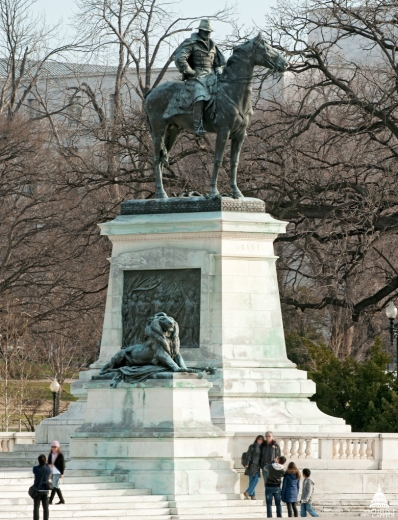
Explore Capitol Hill
Bronze and Marble
1920; dedicated 1922
Sculptor: Henry Merwin Shrady
Architect: Edward Pearce Casey
The memorial to Ulysses S. Grant was dedicated in 1922. It is located in Union Square, west of the U.S. Capitol Building, by the Capitol Reflecting Pool.
The bronze and marble Ulysses S. Grant Memorial by Henry Merwin Shrady is located by the reflecting pool at the east end of the National Mall, west of the United States Capitol. Its central figure depicts the Civil War general (and future president) seated and still on horseback, as was his custom while observing a battle; bronze reliefs on the marble pedestal show infantry soldiers on the march. Four bronze lions around the pedestal impart a sense of strength and dignity. At the ends of the monument, groups of soldiers and horses appear in tumultuous action, with cavalry at the north and artillery at the south. Measuring 44 feet high and occupying a marble platform over 250 feet long and 70 feet deep, the monument is the largest statuary group in Washington, D.C.; the sculpture of Grant is among the largest equestrian statues in the world.
The Congress authorized the creation of the memorial in 1901. Twenty-three sculptors competed for the commission, which was awarded to the relatively unknown Henry Merwin Shrady (1871–1922). A former law student and businessman, Shrady had taught himself to sketch and sculpt, initially by studying animals at the Bronx Zoo. To ensure the accuracy of the Grant Memorial, he studied Civil War history, equipment, and uniforms; joined the New York National Guard; and consulted many war veterans and others who had known the general—including his own father, who had been one of Grant’s physicians. The memorial was completed in 1920; sadly, the sculptor died 15 days before its dedication in 1922. Shrady’s partner in the project was New York architect Edward Pearce Casey (1864–1940), who is also represented in Washington, D.C., by the Taft Memorial Bridge, DAR Constitution Hall, and the completion of the Library of Congress Thomas Jefferson Building.
In late 2011, the care of the monument was transferred from the National Park Service to the Architect of the Capitol.







